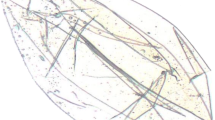Abstract
During the incubation of pigeon eggs, the yolk is transformed from a disordered to an ordered state before being absorbed, and the liquid crystals formed the ordered structure via self-assembly in the yolk. In this study, the relationship between the enzymes (ACPase and Ca-ATPase) and liquid crystal formation within the pigeon endoderm was determined. The results showed that ACPase is critical for transforming the yolk into liquid crystals, which originate mainly from the endoderm. The formation of lamellar structures in the yolk was closely associated with the hydrolytic activity of the enzymes. Additionally, a large amount of Ca-ATPase was expressed in the lamellar structures, indicating modulatory effects of Ca-ATPase on the precipitation of calcium carbonate and appearance of lamellar spherical structures. The liquid crystals containing transport enzymes, which formed as a result of laminarization, serve as reaction sites as well as a reactive source of calcium. The transient receptor potential cation channel subfamily V, member 6 (TRPV6) is an epithelial calcium channel. The present study aimed to elucidate the relationship between yolk sac liquid crystals and calcium transport by investigating the regulatory mechanisms underlying TRPV6 gene expression in the pigeon endoderm. The pattern of expression of TRPV6 observed in this study suggests that yolk sac liquid crystals participate in calcium transport in the endoderm.




Similar content being viewed by others
References
Ando T, Fujimoto K, Mayahara H, Ogawa K (1981) A new one-step method for the histochemistry and cytochemistry of Ca2+-ATPase activity. Acta Histochem Cytoc 14:705–726
Balaban RS (2002) Cardiac energy metabolism homeostasis: role of cytosolic calcium. J Mol Cell Cardiol 34:1259–1271
Brown GH, Wolken JJ (2012) Liquid crystals and biological structures. Academic press, New York
Gomori G (1950) An improved histochemical technique for acid phosphatase. Stain Technol 25:81–85
He HP, Zhou HX, Wang GZ, Wu XZ (1978) In chick embryo yolk liquid crystal state and its biological significance of the preliminary study. J Wuhan Univ (Nat Sci Ed) 4:32–43
Hoenderop JG, Vennekens R, Müller D, Prenen J, Droogmans G, Bindels RJ, Nilius B (2001) Function and expression of the epithelial Ca2+ channel family: comparison of the mammalian epithelial Ca2+ channel 1 and 2. J Physiol 537:747–761
Ivey KN, Muth A, Arnold J, King FW, Yeh RF, Fish JE, Hsiao EC, Schwartz RJ, Conklin BR, Bernstein HS (2008) MicroRNA regulation of cell lineages in mouse and human embryonic stem cells. Cell Stem Cell 2:219–229
Kaprielian Z, Fambrough DM (1987) Expression of fast and slow isoforms of the Ca2+-ATPase in developing chick skeletal muscle. Dev Biol 124:490–503
Kato T (2002) Self-assembly of phase-segregated liquid crystal structures. Science 295:2414–2418
Khanal RC, Peters TM, Smith NM, Nemere I (2008) Membrane receptor-initiated signaling in 1, 25(OH)2D3-stimulated calcium uptake in intestinal epithelial cells. J Cell Biochem 105:1109–1116
Kolter T, Sandhoff K (2005) Principles of lysosomal membrane digestion: stimulation of sphingolipid degradation by sphingolipid activator proteins and anionic lysosomal lipids. Annu Rev Cell Dev Biol 21:81–103
Livak KJ, Schmittgen TD (2001) Analysis of relative gene expression data using real-time quantitative PCR and the 2−ΔΔ CT Method. Methods 25:402–408
Luft HJ (1961) Improvements in epoxy resin embedding methods. J biophys Biochem Cytol 9:409–414
Moriya O, Ichikawa Y (1989) Acid phosphatase in lymphoid tissues of developing chick embryos. Acta Histochem 87:99–105
MÜller D, Hoenderop JGJ, Meij IC, van den Heuvel LPJ, Knoers NVAM, den Hollander AL, Eggert P, Garcia-Nieto V, Claverie-Martin F, Bindels RJM (2000) Molecular cloning, tissue distribution, and chromosomal mapping of the human epithelial calcium channel. Genomics 67:48–53
Nakazawa F, Alev C, Jakt LM, Sheng GJ (2011) Yolk sac endoderm is the major source of serum proteins and lipids and is involved in the regulation of vascular integrity in early chick development. Dev Dynam 240:2002–2010
Peng JB, Chen XZ, Berger UV, Weremowicz S, Morton CC, Vassilev PM, Brown EM, Hediger MA (2000) Human calcium transport protein CaT1. Biochem Biophys Res Commun 278:326–332
Sawalmih AA, Li CH, Siegel S, Fratzl P, Paris O (2009) On the stability of amorphous minerals in lobster cuticle. Adv Mater 21:4011–4015
Seddon J, Templer R (1991) Liquid-crystals and the living cell. New Sci 130:45–49
Song J, Cheng HX, Shen XY, Hu JX, Tong H (2014) Characterization of calcium carbonate crystals in pigeon yolk sacs with different incubation times. Micron 60:39–48
Song J, Cheng HX, Shen XY, Tong H (2015) The effect of pigeon yolk sac fluid on the growth behavior of calcium carbonate crystals. Poult Sci 94:402–407
Stewart GT (2004) Liquid crystals in biology II. origins and processes of life. Liq Cryst 31:443–471
Tauber AI (2003) Metchnikoff and the phagocytosis theory. Nat Rev Mol Cell Biol 4:897–901
Uni Z, Ferket RP (2004) Methods for early nutrition and their potential. World Poult Sci J 60:101–111
Wang TY, Liu M, Portincasa P, Wang DQH (2013) New insights into the molecular mechanism of intestinal fatty acid absorption. Eur J Clin Invest 43:1203–1223
Westerskov K (1950) Methods for determining the age of game bird eggs. J Wildlife Manag 14:56–67
Yu SH, Cölfen H (2004) Bio-inspired crystal morphogenesis by hydrophilic polymers. J Mater Chem 14:2124–2147
Zohn IE, Sarkar AA (2010) The visceral yolk sac endoderm provides for absorption of nutrients to the embryo during neurulation. Birth Defects Res A Clin Mol Teratol 88:593–600
Author information
Authors and Affiliations
Corresponding author
Electronic supplementary material
Below is the link to the electronic supplementary material.
Rights and permissions
About this article
Cite this article
Song, J., Tong, H. Relationship Between Yolk Sac Liquid Crystal Formation and Calcium Transport in Pigeon Egg Yolk Sac Endoderm. Agric Res 7, 232–238 (2018). https://doi.org/10.1007/s40003-018-0313-y
Received:
Accepted:
Published:
Issue Date:
DOI: https://doi.org/10.1007/s40003-018-0313-y



